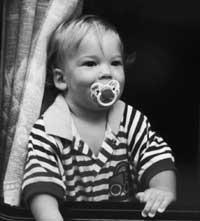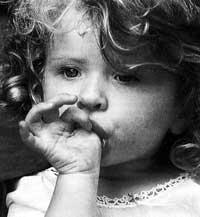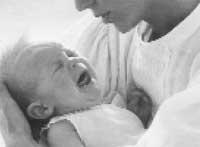Chupete, first toy
1994/11/01 Agirre, Jabier - Medikua eta OEEko kidea Iturria: Elhuyar aldizkaria
From birth to the appearance of the first teeth develops the need to suck or bite babies. It is a physical and psychic need that requires the appropriate instruments to reassure and properly develop the child.
Milk is the only food the child will take in the first months of his life. And for one reason or another, every day it is more frequent that the mother cannot breastfeed her child. Artificial lactation is today a reality that has strengthened the research and development of bottles and dummies specially adapted for the exercise of maternal breast function.
The child will often feel the need to suck, which prompts to bring anything to the mouth. The pacifiers are used to suck and relax that instinct. Despite its antiquity, the characteristics that this tool should gather, in terms of functionality, design and material, are currently the subject of debate.
Two opposing positions

In general, on the market there are two types of pacifiers: soft pacifiers (all of rubber, without hard parts that can harm the child) and hard pacifiers (with an indeformable disc so that the younger children do not ingest it).
While the first ones are based on softness, in the second highlights safety. These two concepts, softness and security, are marginal theoretical level, but if they come into practice, the limp is there: how to marry both factors? The best solution is to use a hard disk, but always with the right shape so that it does not fit the child's mouth and does not hurt.
In the manufacture of dummies are mainly used two types of materials: rubber or rubber and silicone. Rubber is a natural product, very resistant, but because its surface is full of pores, the bacteria facilitates its placement and reproduction. Silicone, on the other hand, is a synthetic, transparent and totally non-toxic product, which does not vary with sterilization after boiling. It does not absorb water and is completely hygienic. Today, for aesthetic reasons and of very adequate durability, the silicone pacifier is very successful.
For the benefit of the teeth?
Research in the form of these objects has taken many steps, always looking forward. The mother always wants her baby to have beautiful, well-placed dentures and a palate without any malformation. But, can it be said that the pacifier meets the above requirements?
First, it is essential that the nipple of the pacifier is made of soft and flexible materials, even if it is difficult to break. If the tetina is hard or has strong parts inside, it will probably deform the cold bow and palate.
According to studies, the pacifier with anatomical tetina is considered as recommended. It has also been observed that the child is accustomed to this form, since it is the one that most resembles the breast of his mother.
A study carried out by the dental clinic of the Witten/Herdecke University of Germany yielded curious results: 2,500 children were analyzed who went to the nursery and while those who used the pacifier were 5% (about 120 children), eight times more were children who sucked their finger (40%, ie more than 1,000 children). As for 6-year-old boys and girls, the chupetistas were only 0.3%, while those who continued to suck their big finger were at a very high percentage, 38%.
And the reasons for these differences are many. But the first thing we have to look at is the difficulty they have to leave that “bad” custom. And you can understand a lot, because the pacifier “disappears” at any moment, but the finger does not. In addition, the child immediately invents a discreet way of inserting the finger into the mouth, almost hidden to conceal, for example, by placing the hand. And this custom does not provoke ridicule or laughter from the school's friends, even though the use of the pacifier would imply.
Does the pacifier not hurt?
It is convenient to put all things in their point and here you also hear anything through there.
- Using the pacifier can cause dental deviations.With the approved pacifier this is almost impossible, unless it is used for longer than necessary (it should be removed from the two years).
- The pacifier produces winds or gases in the intestines. This is not true because the gases are usually a result of poor digestion, or because the nipple of the bottle has a very small hole (which forces the child to make great efforts) or because the bottle is placed in an inadequate posture (in this way air can form while drinking).
- Do not give suck.Eye! Not sucking the newborn can be somewhat counterproductive, since the child can get used to sucking his big finger and in this case, when the time comes, it will cost him much more to abandon this custom. It is not so rare to find adults who carry their finger to their mouth at bedtime.
The use of the pacifier is recommended as long as the following points are maintained:
- The pacifier will always be homologated.
- It is sterilised in boiling water or in special liquids that are sold in pharmacies.
- The tetina will never be enjoyed with sugar or honey, as this way too much sugar (glucose) is ingested for the child, which in the long run would generate cavities.
- The pacifier should be used to reassure the child and at his convenience, not for the convenience of the parents. So if the child does not want to suck, there is no need to insist.
- The use of the pacifier at two years of age is not recommended.
- The pacifiers will not hang from the chains or catecorratos, since while sleeping the child can drown with the first ones or pierce with the second ones.

Gai honi buruzko eduki gehiago
Elhuyarrek garatutako teknologia






